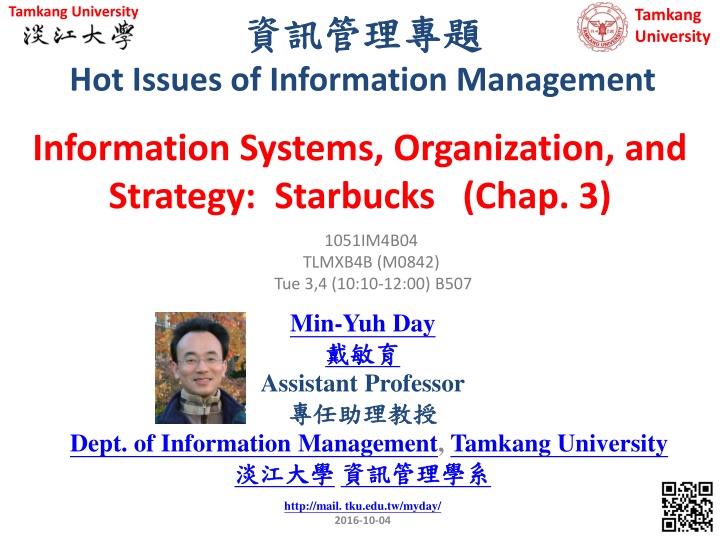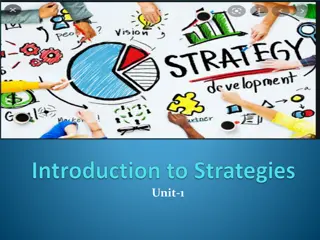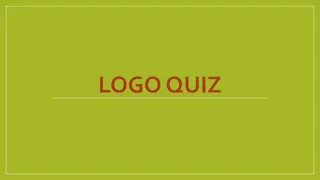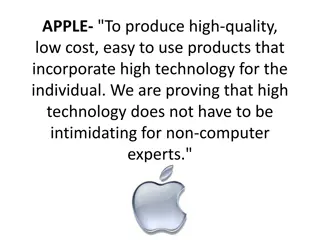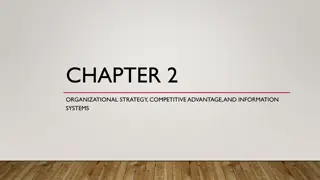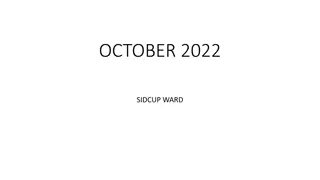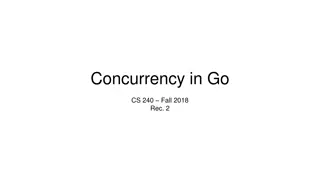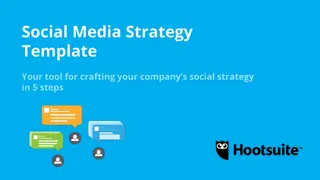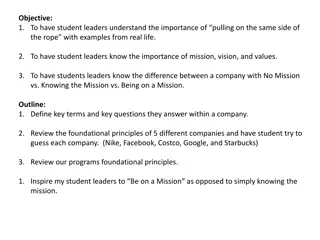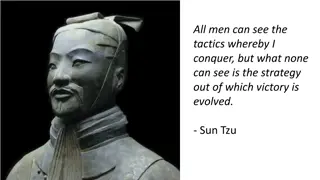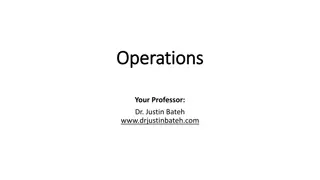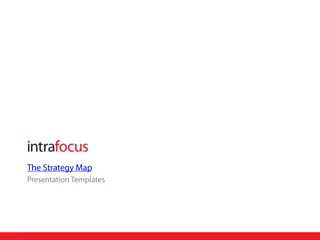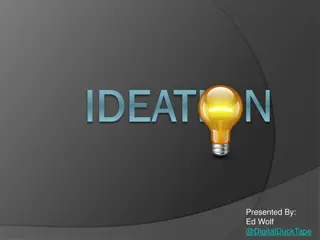Analysis of Starbucks Business Strategy Using Technology
Explore how Starbucks leverages technology to enhance its competitive positioning and business strategy. Analyze the role of technology in Starbucks' competitive forces, value chain, and overall strategy. Evaluate the effectiveness of technology in helping Starbucks gain a competitive edge in the market.
Download Presentation

Please find below an Image/Link to download the presentation.
The content on the website is provided AS IS for your information and personal use only. It may not be sold, licensed, or shared on other websites without obtaining consent from the author.If you encounter any issues during the download, it is possible that the publisher has removed the file from their server.
You are allowed to download the files provided on this website for personal or commercial use, subject to the condition that they are used lawfully. All files are the property of their respective owners.
The content on the website is provided AS IS for your information and personal use only. It may not be sold, licensed, or shared on other websites without obtaining consent from the author.
E N D
Presentation Transcript
Tamkang University Tamkang University Hot Issues of Information Management Information Systems, Organization, and Strategy: Starbucks (Chap. 3) 1051IM4B04 TLMXB4B (M0842) Tue 3,4 (10:10-12:00) B507 Min-Yuh Day Assistant Professor Dept. of Information Management, Tamkang University http://mail. tku.edu.tw/myday/ 2016-10-04 1
(Syllabus) (Week) (Date) (Subject/Topics) 1 2016/09/13 Introduction to Case Study for Information Management Hot Topics 2 2016/09/20 Information Systems in Global Business: UPS (Chap. 1) (pp.53-54) 3 2016/09/27 Global E-Business and Collaboration: P&G (Chap. 2) (pp.84-85) 4 2016/10/04 Information Systems, Organization, and Strategy: Starbucks (Chap. 3) (pp.129-130) 5 2016/10/11 Ethical and Social Issues in Information Systems: Facebook (Chap. 4) (pp.188-190) 2
(Syllabus) (Week) (Date) (Subject/Topics) 6 2016/10/18 IT Infrastructure and Emerging Technologies: Amazon and Cloud Computing (Chap. 5) (pp. 234-236) 7 2016/10/25 Foundations of Business Intelligence: IBM and Big Data (Chap. 6) (pp.261-262) 8 2016/11/01 Telecommunications, the Internet, and Wireless Technology: Google, Apple, and Microsoft (Chap. 7) (pp.318-320) 9 2016/11/08 Midterm Report ( ) 10 2016/11/15 3
(Syllabus) Subject/Topics 11 2016/11/22 Enterprise Applications: Summit and SAP (Chap. 9) (pp.396-398) 12 2016/11/29 E-commerce: Zagat (Chap. 10) (pp.443-445) 13 2016/12/06 Enhancing Decision Making: Zynga (Chap. 12) (pp.512-514) 14 2016/12/13 Building Information Systems: USAA (Chap. 13) (pp.547-548) 15 2016/12/20 Managing Projects: NYCAPS and CityTime (Chap. 14) (pp.586-588) 16 2016/12/27 Final Report I ( I) 17 2017/01/03 Final Report II ( II) 18 2017/01/10 4
Management Information Systems: Managing the Digital Firm 1 2 Organization, Management, and the Networked Enterprise Information Technology Infrastructure 3 4 Key System Applications for the Digital Age Building and Managing Systems 5 Source: Kenneth C. Laudon & Jane P. Laudon (2014), Management Information Systems: Managing the Digital Firm, Thirteenth Edition, Pearson.
Chap. 3 Information Systems, Organization, and Strategy: Starbucks 6
Case Study: Starbucks (Chap. 3) (pp.129-130) Technology Helps Starbucks Find New Ways to Compete 1. Analyze Starbucks using the competitive forces and value chain models. 2. What is Starbucks business strategy? Assess the role played by technology in this business strategy. 3. How much has technology helped Starbucks compete? Explain your answer. 7 Source: Kenneth C. Laudon & Jane P. Laudon (2014), Management Information Systems: Managing the Digital Firm, Thirteenth Edition, Pearson.
Overview of Fundamental MIS Concepts Business Challenges Management Information System Business Solutions Organization Technology 8 Source: Kenneth C. Laudon & Jane P. Laudon (2014), Management Information Systems: Managing the Digital Firm, Thirteenth Edition, Pearson.
Business Model 2 8 6 4 1 Key Customer Relationships Activities Value Proposition Key Customer Segments Partners 3 7 Key Channels Resources 9 5 Cost Revenue Streams Structure 9 Source: Alexander Osterwalder & Yves Pigneur, Business Model Generation: A Handbook for Visionaries, Game Changers, and Challengers, Wiley, 2010.
THE TWO-WAY RELATIONSHIP BETWEEN ORGANIZATIONS AND INFORMATION TECHNOLOGY 10 Source: Kenneth C. Laudon & Jane P. Laudon (2014), Management Information Systems: Managing the Digital Firm, Thirteenth Edition, Pearson.
Definition of Organization What is an organization? Technical definition: Stable, formal social structure that takes resources from environment and processes them to produce outputs A formal legal entity with internal rules and procedures, as well as a social structure Behavioral definition: A collection of rights, privileges, obligations, and responsibilities that is delicately balanced over a period of time through conflict and conflict resolution 11 Source: Kenneth C. Laudon & Jane P. Laudon (2014), Management Information Systems: Managing the Digital Firm, Thirteenth Edition, Pearson.
THE TECHNICAL MICROECONOMIC DEFINITION OF THE ORGANIZATION Capital and labor (the primary production factors provided by the environment) are transformed by the firm through the production process into products and services (outputs to the environment). The products and services are consumed by the environment, which supplies additional capital and labor as inputs in the feedback loop. 12 Source: Kenneth C. Laudon & Jane P. Laudon (2014), Management Information Systems: Managing the Digital Firm, Thirteenth Edition, Pearson.
THE BEHAVIORAL VIEW OF ORGANIZATIONS 13 Source: Kenneth C. Laudon & Jane P. Laudon (2014), Management Information Systems: Managing the Digital Firm, Thirteenth Edition, Pearson.
ROUTINES, BUSINESS PROCESSES, AND FIRMS 14 Source: Kenneth C. Laudon & Jane P. Laudon (2014), Management Information Systems: Managing the Digital Firm, Thirteenth Edition, Pearson.
ENVIRONMENTS AND ORGANIZATIONS HAVE A RECIPROCAL RELATIONSHIP 15 Source: Kenneth C. Laudon & Jane P. Laudon (2014), Management Information Systems: Managing the Digital Firm, Thirteenth Edition, Pearson.
Disruptive Technologies Technology that brings about sweeping change to businesses, industries, markets Examples: personal computers, word processing software, the Internet, the PageRank algorithm First movers and fast followers First movers inventors of disruptive technologies Fast followers firms with the size and resources to capitalize on that technology 16 Source: Kenneth C. Laudon & Jane P. Laudon (2014), Management Information Systems: Managing the Digital Firm, Thirteenth Edition, Pearson.
5 Basic Kinds of Organizational Structure Entrepreneurial: Small start-up business Machine bureaucracy: Midsize manufacturing firm Divisionalized bureaucracy: Fortune 500 firms Professional bureaucracy: Law firms, school systems, hospitals Adhocracy: Consulting firms 17 Source: Kenneth C. Laudon & Jane P. Laudon (2014), Management Information Systems: Managing the Digital Firm, Thirteenth Edition, Pearson.
THE TRANSACTION COST THEORY OF THE IMPACT OF INFORMATION TECHNOLOGY ON THE ORGANIZATION 18 Source: Kenneth C. Laudon & Jane P. Laudon (2014), Management Information Systems: Managing the Digital Firm, Thirteenth Edition, Pearson.
THE AGENCY THEORY OF THE IMPACT OF INFORMATION TECHNOLOGY ON THE ORGANIZATION 19 Source: Kenneth C. Laudon & Jane P. Laudon (2014), Management Information Systems: Managing the Digital Firm, Thirteenth Edition, Pearson.
FLATTENING ORGANIZATIONS 20 Source: Kenneth C. Laudon & Jane P. Laudon (2014), Management Information Systems: Managing the Digital Firm, Thirteenth Edition, Pearson.
ORGANIZATIONAL RESISTANCE AND THE MUTUALLY ADJUSTING RELATIONSHIP BETWEEN TECHNOLOGY AND THE ORGANIZATION 21 Source: Kenneth C. Laudon & Jane P. Laudon (2014), Management Information Systems: Managing the Digital Firm, Thirteenth Edition, Pearson.
Using Information Systems to Achieve Competitive Advantage Why do some firms become leaders in their industry? Michael Porter s competitive forces model Provides general view of firm, its competitors, and environment Five competitive forces shape fate of firm: 1. Traditional competitors 2. New market entrants 3. Substitute products and services 4. Customers 5. Suppliers 22 Source: Kenneth C. Laudon & Jane P. Laudon (2014), Management Information Systems: Managing the Digital Firm, Thirteenth Edition, Pearson.
PORTERS COMPETITIVE FORCES MODEL 23 Source: Kenneth C. Laudon & Jane P. Laudon (2014), Management Information Systems: Managing the Digital Firm, Thirteenth Edition, Pearson.
Information System Strategies for Dealing with Competitive Forces 1. Low-cost leadership 2.Product differentiation 3. Focus on market niche 4. Strengthen customer and supplier intimacy 24 Source: Kenneth C. Laudon & Jane P. Laudon (2014), Management Information Systems: Managing the Digital Firm, Thirteenth Edition, Pearson.
Information System Strategies for Dealing with Competitive Forces 1. Low-cost leadership Produce products and services at a lower price than competitors while enhancing quality and level of service Examples: Walmart s efficient customer response system 25 Source: Kenneth C. Laudon & Jane P. Laudon (2014), Management Information Systems: Managing the Digital Firm, Thirteenth Edition, Pearson.
Information System Strategies for Dealing with Competitive Forces 2. Product differentiation Enable new products or services, greatly change customer convenience and experience Examples: Google, Nike, Apple Mass customization 26 Source: Kenneth C. Laudon & Jane P. Laudon (2014), Management Information Systems: Managing the Digital Firm, Thirteenth Edition, Pearson.
Information System Strategies for Dealing with Competitive Forces 3. Focus on market niche Use information systems to enable a focused strategy on a single market niche; specialize Example: Hilton Hotels 27 Source: Kenneth C. Laudon & Jane P. Laudon (2014), Management Information Systems: Managing the Digital Firm, Thirteenth Edition, Pearson.
Information System Strategies for Dealing with Competitive Forces 4. Strengthen customer and supplier intimacy Use information systems to develop strong ties and loyalty with customers and suppliers Increase switching costs Example: Netflix, Amazon 28 Source: Kenneth C. Laudon & Jane P. Laudon (2014), Management Information Systems: Managing the Digital Firm, Thirteenth Edition, Pearson.
The Internets impact on competitive advantage Transformation, destruction, threat to some industries Examples: travel agency, printed encyclopedia, newspaper Competitive forces still at work, but rivalry more intense Universal standards allow new rivals, entrants to market New opportunities for building brands and loyal customer bases 29 Source: Kenneth C. Laudon & Jane P. Laudon (2014), Management Information Systems: Managing the Digital Firm, Thirteenth Edition, Pearson.
THE VALUE CHAIN MODEL 30 Source: Kenneth C. Laudon & Jane P. Laudon (2014), Management Information Systems: Managing the Digital Firm, Thirteenth Edition, Pearson.
THE VALUE WEB 31 Source: Kenneth C. Laudon & Jane P. Laudon (2014), Management Information Systems: Managing the Digital Firm, Thirteenth Edition, Pearson.
Synergies Information systems can improve overall performance of business units by promoting synergies and core competencies Synergies When output of some units used as inputs to others, or organizations pool markets and expertise Example: merger of Bank of NY and JPMorgan Chase Purchase of YouTube by Google 32 Source: Kenneth C. Laudon & Jane P. Laudon (2014), Management Information Systems: Managing the Digital Firm, Thirteenth Edition, Pearson.
Core competencies Activity for which firm is world-class leader Relies on knowledge, experience, and sharing this across business units Example: Procter & Gamble s intranet and directory of subject matter experts 33 Source: Kenneth C. Laudon & Jane P. Laudon (2014), Management Information Systems: Managing the Digital Firm, Thirteenth Edition, Pearson.
Network-based strategies Take advantage of firm s abilities to network with each other Include use of: Network economics Virtual company model Business ecosystems 34 Source: Kenneth C. Laudon & Jane P. Laudon (2014), Management Information Systems: Managing the Digital Firm, Thirteenth Edition, Pearson.
Traditional economics Network economics Traditional economics: Law of diminishing returns The more any given resource is applied to production, the lower the marginal gain in output, until a point is reached where the additional inputs produce no additional outputs Network economics: Marginal cost of adding new participant almost zero, with much greater marginal gain Value of community grows with size Value of software grows as installed customer base grows 35 Source: Kenneth C. Laudon & Jane P. Laudon (2014), Management Information Systems: Managing the Digital Firm, Thirteenth Edition, Pearson.
Virtual company strategy Virtual company uses networks to ally with other companies to create and distribute products without being limited by traditional organizational boundaries or physical locations Example: Li & Fung manages production, shipment of garments for major fashion companies, outsourcing all work to more than 7,500 suppliers 36 Source: Kenneth C. Laudon & Jane P. Laudon (2014), Management Information Systems: Managing the Digital Firm, Thirteenth Edition, Pearson.
Business ecosystems Industry sets of firms providing related services and products Microsoft platform used by thousands of firms Walmart s order entry and inventory management Keystone firms: Dominate ecosystem and create platform used by other firms Niche firms: Rely on platform developed by keystone firm Individual firms can consider how IT will help them become profitable niche players in larger ecosystems 37 Source: Kenneth C. Laudon & Jane P. Laudon (2014), Management Information Systems: Managing the Digital Firm, Thirteenth Edition, Pearson.
AN ECOSYSTEM STRATEGIC MODEL 38 Source: Kenneth C. Laudon & Jane P. Laudon (2014), Management Information Systems: Managing the Digital Firm, Thirteenth Edition, Pearson.
Using Information Systems for Competitive Advantage: Management Issues Sustaining competitive advantage Competitors can retaliate and copy strategic systems Systems may become tools for survival Aligning IT with business objectives Performing strategic systems analysis Structure of industry Firm value chains Managing strategic transitions Adopting strategic systems requires changes in business goals, relationships with customers and suppliers, and business processes 39 Source: Kenneth C. Laudon & Jane P. Laudon (2014), Management Information Systems: Managing the Digital Firm, Thirteenth Edition, Pearson.
Definition of Business Model A business model describes the rationale of how an organization creates, delivers, and captures value. 40 Source: Alexander Osterwalder & Yves Pigneur, Business Model Generation: A Handbook for Visionaries, Game Changers, and Challengers, Wiley, 2010.
Definition of Business Strategy A business strategy is a long term plan of action designed to achieve a particular goal or set of goals or objectives. 41 Source: (Ostenwalder, Pigneur and Tucci, 2005)
Business the activity of providing goods and services involving financial, commercial and industrial aspects. (WordNet 2.0) Source: (Ostenwalder, Pigneur and Tucci, 2005) 42
Model a simplified description and representation of a complex entity or process. (WordNet 2.0) Source: (Ostenwalder, Pigneur and Tucci, 2005) 43
Business Model vs. Business Process Model Business Model a view of the firm's logic for creating and commercializing value Business process model how a business case is implemented in processes Source: (Ostenwalder, Pigneur and Tucci, 2005) 44
Business Model vs. Strategy Business Models a system that shows how the pieces of a business fit together. an abstraction of a firm's strategy Strategy includes competition Source: (Ostenwalder, Pigneur and Tucci, 2005) 45
The Business Model's Place in the Firm Source: (Ostenwalder, Pigneur and Tucci, 2005) 46 46
Business Strategy and Information Systems Alignment Source: (Ostenwalder, Pigneur and Tucci, 2005) 47
Case Study: Facebook (Chap. 4) (pp.188-190) Facebook: It s about the Money 1. Perform an ethical analysis of Facebook. What is the ethical dilemma presented by this case? 2. What is the relationship of privacy to Facebook s business model? 3. Describe the weaknesses of Facebook s privacy policies and features. What management, organization, and technology factors have contributed to those weaknesses? 4. Will Facebook be able to have a successful business model without invading privacy? Explain your answer. Are there any measures Facebook could take to make this possible? 48 Source: Kenneth C. Laudon & Jane P. Laudon (2014), Management Information Systems: Managing the Digital Firm, Thirteenth Edition, Pearson.
(Hot Issues of Information Management) 1. 2. 3. 4. 3,4 (10:10-12:00) B507 49
References Kenneth C. Laudon & Jane P. Laudon (2014), Management Information Systems: Managing the Digital Firm, Thirteenth Edition, Pearson. Kenneth C. Laudon & Jane P. Laudon (2014) 13 50
